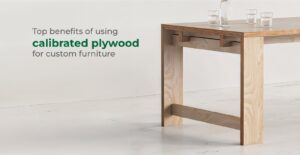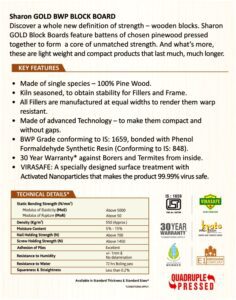

Amidst the clatter of power tools and the buzz of construction sites, plywood quietly takes its place as the silent partner that holds it all together. It is, without a doubt, one of the most versatile and dependable materials in the world of construction and design. But what sets plywood apart from the rest? Let’s explore why plywood’s structure and strength are the backbone of countless architectural marvels and household necessities.
The Structure and Strength
Before we dive deeper into the reasons behind plywood’s remarkable strength, let’s understand its structure. At its core, plywood is a layered construction that combines the inherent strength of wood with a remarkable degree of engineering precision. The process involves taking thin sheets of wood, known as veneers, and laminating them together with the grains of adjacent layers running perpendicular to one another. The result is a robust, engineered wood product that outperforms solid timber in many applications. It resists warping and maintains its shape, ensuring long-term durability.
Here are some key factors that contribute to the exceptional structure and strength of plywood:
A World of Uses
From supporting beams to the subflooring in your home, plywood finds its place in a multitude of applications. It serves as a versatile and reliable material for a wide range of structural, decorative, and functional purposes. Its immense strength, combined with its affordability, makes it a top choice for both professionals and DIY enthusiasts.
Plywood’s strength isn’t limited to mere load-bearing capabilities. It also excels at flexibility, adapting to curved surfaces and intricate designs. This quality makes it a favorite among furniture makers, builders, and artisans, allowing them to bring their creative visions to life.
As we conclude, plywood’s structure and strength, often hidden behind layers of paint or concealed beneath a beautiful veneer, are an engineering marvel that warrants our admiration. This unassuming material quietly upholds the buildings we live and work in, the furniture we cherish, and the designs we create. Its strength, versatility, and sustainability play an indispensable role in modern construction and design. Its structure and strength are the foundation of modern craftsmanship and design, making it a worthy subject of admiration.










Users understand that SHARONPLY is committed to protecting the User’s privacy and shall take all efforts to protect any personal data provided to the Website by reasonable security safeguards against such risks as loss or unauthorised use, destruction, modification or disclosure of data, However, in case of any lapse, SHARONPLY shall not be held responsible for any effect or consequences thereof. The Website uses cookies to track usage of the path of the User. Since most web browsers automatically accept cookies, User can edit User’s browser options to block them if User does not want the Website to use cookies to track usage of the path of the User.
SHARONPLY undertakes not to disclose, except as otherwise provided, the personal information provided by the User to any person, unless such action is necessary to: –
By filling up any form on the Website User automatically grants SHARONPLY a royalty-free, perpetual, irrevocable non-exclusive license to use, reproduce, publish, edit, distribute, and publicly display the information given in the form and to sublicense such rights.
Any queries regarding the SHARONPLY’s privacy policy, may be sent to admin@sharonply.com.

